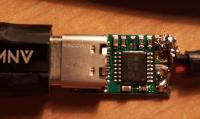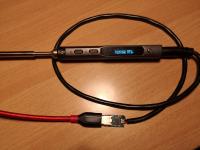There has been a hype around the small soldering iron Miniware TS100 for a while now. It is one of the few compact soldering irons that have enough power to be a reasonable coice for a portable soldering iron.
I must admit that many soldering irons feel like a toy against my Ersa iCon with its 150 Watts and a heating element that is very close to the tip. With the iCon, soldering a big connector is as easy as soldering a small SMD resistor. The TS100 might run out of steam on a connector with much thermal mass, but on smaller joints, which make up the majority of my soldering jobs, it’s totally fine. For its up to 65 W, it does a decent job. The casual soldering nerd of course installs a different firmware for more features.
Looking at ergonomics, the iCon also wins. Not only because of its superior balance, but also with its haptics. Adding a rubber front mantle to the TS100 would probably improve haptics, since it’s just a piece of hard plastic. Also, the iCon soldering irons come with a decent silicone cable that is thin, lightweight, flexible and temperature-resistant. You can get such a silicone cable for the TS100 easily e.g. by buying the battery pack adaptor cable with an XT60 jack. So far, I’ve used an old ThinkPad power supply that has a thick plastic cable, which I can’t recommend for fine-pitch soldering.
Later, I got a new phone that came with USB-C. Also, the TS80 came out, which has USB-C, too. Why not put USB-C on my TS100? I remembered that USB-C enables USB Power Delivery, more exactly USB-PD rev. 2. That revision demands that power supplies with more than 45 W suport a 20 V mode, which is almost perfect for the TS100. In contrast, USB-PD rev. 1 could also support 60 W with only 12 V, which wouldn’t work in this case. Because the TS100 heater is just a resistor that is connected to the power supply, it obeys P=U²/R and its power drops from 65 W at 24 V to only 45 W at 20 V. Still good enough for being so compact, I’d say.
So, I got myself a USB-C power supply with USB-PD rev. 2 and 56 Watts and a USB-C cable. But how do you speak USB-PD? Fortunately, people in Shenzhen asked the same question and came up with a tiny board that is a USB-PD sink. You can find it with names like “ZY12PDS Type-C USB-C PD2.0 3.0 to DC USB decoy fast charge trigger detector”. It’s just a USB-C jack, a IP2721 USB-PD controller made by Injoinic and a few components. All that’s left to do is to set the solder bridge for 20 V output on the module, solder the abovementioned cable with the XT60 connector to the board, wrap everything in tape and connect the USB-C power supply. And that’s it, now I have a small, portable soldering iron with enough power for most soldering jobs.

